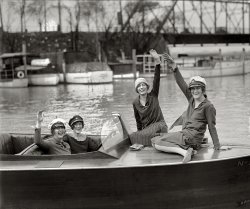
MAY CONTAIN NUTS

Search Shorpy
SHORPY ART

Framed or unframed, desk size to sofa size, printed by us in Arizona and Alabama since 2007. Explore now.
Join and Share
Ad-Free Shorpy
Shorpy is funded by you. Patreon contributors get an ad-free experience.
Learn more.

Recent comments
- Baldwin 62303
- Baldwin VO-1000
- Cold
- No expense spared
- Tough Guys
- Lost in Toyland
- And without gloves
- If I were a blindfolded time traveler
- Smoke Consumer Also Cooks
- Oh that stove!
- Possibly still there?
- What?!?
- $100 Reward
- Freeze Frame
- Texas Flyer wanted
- Just a Year Too Soon
- WWII -- Replacing men with women at the railroad crossing.
- Yes, Icing
- You kids drive me nuts!
- NOT An Easy Job
- I wonder
- Just add window boxes
- Icing Platform?
- Indiana Harbor Belt abides
- Freezing haze
- Corrections (for those who care)
- C&NW at Nelson
- Fallen Flags
- A dangerous job made worse
- Water Stop
Member Photos
The Shorpy
Print Emporium
Print Emporium
Search Shorpy
Search results -- 30 results per page
- Ragged Point: 1950
- Chesapeake Bay (Maryland) ca. 1950. "Water scenes. Boat in foreground, lighthouse in distance. Made for Mr. Sharpe of Potomac ... Posted by Dave - 04/02/2021 - 11:15am -
![Ragged Point: 1950 Chesapeake Bay (Maryland) ca. 1950. "Water scenes. Boat in foreground, lighthouse in distance. Made for Mr. Sharpe of Potomac Electric Power Co." Ragged Point Light in the Potomac River. 5x7 inch nitrate negative by Theodor Horydczak. View full size.
Une barque sur l'océanI suppose it is appropriate a fine exemplification of littoral imagery would be captured by a man named Theodor Hydroczak.
[my apologies]
Y thoThe Shorpy logo going down to the depths? Never!
Chesapeake Bay, MarylandWell that's kind of vague.
[Try reading the rest of the caption. - Dave]
Not a Screw Pile AnymoreThe lighthouse is now a traditional light house on dry land.
Screw-pile lighthouseRagged Point Light was a so-called screw-pile lighthouse.
(The Gallery, Boats & Bridges, D.C., Landscapes, Theodor Horydczak)](https://www.shorpy.com/files/images/SHORPY-5a47204u1.thumbnail.jpg)
- Rotterdam Canal, 1904
- ... meaning "water" in Dutch as well and "boot" meaning "boat". "Spui" used to be an old name for a water outlet (the best-known "Spui" ... a photo showing the water of a canal named "Spui" with a boat in it.
The most probable candidate for this photo's location might be ... Posted by billinmn - 09/21/2011 - 12:10am -
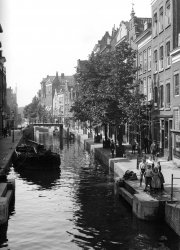
- Pittsburgh: 1956
- ... of its 1950s urban renewal. First of all, it's shot from a boat in the Monongahela, which is unusual (especially since, given the steam ... Posted by Dave - 01/28/2013 - 11:58am -
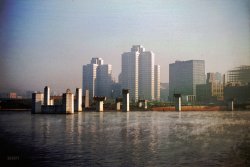
- Knotty Gobs: 1899
- July 3, 1899. "U.S.S. New York , apprentice boat crew, anniversary of Battle of Santiago." Photo by Edward H. Hart, Detroit ... Posted by Dave - 08/10/2012 - 12:30am -
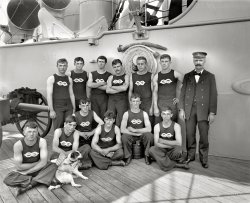
- Trailer Life: 1941
- ... years and spending time with my brother who pulls his boat and camper down to the park and goes fishing.
Obvious comment It's ... Posted by Dave - 09/17/2019 - 7:49pm -
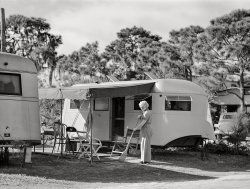
- Spar Deck Swabbies: 1898
- ... comment from Capn_Jack, thanks! I also noted four (4ea) boat support pads mounted above the spars with turnbuckles for adjustability. ... Posted by Dave - 11/01/2014 - 10:46am -
![Spar Deck Swabbies: 1898 Circa 1898. "League Island Navy Yard, Philadelphia. U.S.S. Brooklyn spar deck." 8x10 inch glass negative, Detroit Publishing Company. View full size.
The large intake tubesLandlubber here so might be a dumb query. What are those huge tubes used for on these old ships? I assume air intake for down below?
[Yes. Ventilator ports. - Dave]
What are those "pads" called?Very interesting comment from Capn_Jack, thanks! I also noted four (4ea) boat support pads mounted above the spars with turnbuckles for adjustability. I wonder if they have a name.
Vampire ShipThe Photographer caught Nosferatu coming up the stairs.
Devil's in the detailsLots of neat details in this one. The intake ventilators TonyB asked about,-- usually these big ones are for the boiler room combustion supply as well as to cool the stokers as they fed coal into the furnaces -- are adjustable. There is a drive pinion shaft running up each one with a ring of gear teeth around the exterior (see the one top center). This would allow the crew to trim the ventilators to the wind direction so they could scoop as much air as possible. On some ships in this period boilers worked by natural draft -- the ventilators were not being helped by mechanical fans -- and this arrangement was much more common on cruisers that could handle the very tall funnels natural draft required. It seems likely Brooklyn was using wind to help her boilers get more air. More air, faster combustion, more power.
The second detail is the spars resting on the beams overhead. These spars might have been for the ship's boats. In this period, ships' boats were often sail and/or oar powered, with one or two steam launches. Cruisers had a large complement of boats since they often did service in remote areas. The "string of beads" thing at the end of a spar is a parrel -- a feature from the age of sail that slid (rolled on the beads actually) up and down on a mast to allow a gaff or yard to be hoisted smoothly. The shape of the jaws suggests a gaff, and the size of the wire loop suggests it's for one of the boats rather than for the ship itself.
Intake tubesWe still have them on some older ships; they're called scoops. At one point you could find them on cabin portholes too, which could be adjusted to redirect air into your living space, primitive "A/C" for the mariner!
(The Gallery, Boats & Bridges, DPC, Philadelphia)](https://www.shorpy.com/files/images/SHORPY-4a14048a.thumbnail.jpg)
- Color Wheels: 1943
- ... and rationing. Those boys are happy to be sending another boat on the way to fight Hitler and Tojo, I think. They're also happy because ... Posted by Dave - 08/16/2017 - 12:03pm -
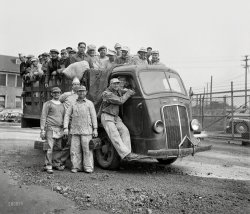
- First of the Mohicans: 1904
- ... at Point Vivian, near the International Bridge. Our only boat was a double oar-lock skiff very similar to the ones pictured.
It was a beautifully made and maintained wooden boat, but I yearned for something with an outboard motor and drooled over the ... Posted by Dave - 06/11/2016 - 8:02pm -
![First of the Mohicans: 1904 1904. "Sagamore Hotel dock, Green Island, Lake George, N.Y." 8x10 inch dry plate glass negative, Detroit Publishing Company. View full size.
SkiffsThose row boats are what we called St Lawrence skiffs when I was a kid. My family had a cottage on the St Lawrence River at Point Vivian, near the International Bridge. Our only boat was a double oar-lock skiff very similar to the ones pictured.
It was a beautifully made and maintained wooden boat, but I yearned for something with an outboard motor and drooled over the Chris-Crafts and other inboards seen at the public docks in Alexandria Bay!
Mohican I (1894 - 1908)"The first Mohican [shown here] was built in Lake George Village on Pine Point. She was launched in 1894, she was 93 feet long and 17 feet wide and weighed 150 tons (the current Mo weighs 200 tons). She was propelled by a single 200 horsepower steam engine which worked a single propeller.
"She wasn't originally built for the Steamboat Company, but she was later purchased by the company. The company then improved the main deck, added steam heating, carpeting, and toilets among other things.
"She sailed daily from Baldwin (Ticonderoga) at 7:20 am, stopping at all of the landings when signaled to, and arrived at Caldwell just in time to catch the 11:25 am southbound train. She then left Caldwell to head back up to Ti at 2:45 pm and (once again after making all her landings) arrived in Baldwin at 6:30 pm. During busy times in the summer, she also made stops in Paradise Bay and the Narrows.
"After 14 years of faithful service the Mohican (I) was retired on 1908, just as the new steel-hulled Mohican (II) was rolled into service to replace her. The first Mohican was dismantled in Ticonderoga that same year."
Source: Lake George Steamboat Company.
The Lake George Steamboat Company turns 200 years old in 2017.
The Mohican II, which is still in service and is on the National Register of Historic Places, also has the antlers mounted at the top of the wheel house. The Mohican II is shown in the first photo below, and the other photo shows another view of the Mohican I.
(The Gallery, Boats & Bridges, DPC)](https://www.shorpy.com/files/images/SHORPY-4a11456a.thumbnail.jpg)
- Down and Dirty: 1910
- ... drowned trying to save the lives of others after the boat ran into a rock.
(The Gallery, Lewis Hine, St. Louis) ... Posted by Dave - 02/28/2013 - 1:24pm -
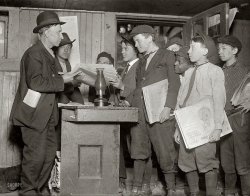
- A Higher Power: 1937
- ... from Wall Street where he was sworn in, to St. P's by boat - as it was faster.
At the time, the graveyard was on a gently sloping ... Posted by Dave - 05/01/2019 - 1:03pm -
![A Higher Power: 1937 March 2, 1937. New York City. "St. Paul's chapel and churchyard, Broadway and Fulton streets." Overshadowed by two proto-skyscrapers from the 1890s, the Park Row and St. Paul buildings. Photo by Arnold Moses for the Historic American Buildings Survey. View full size.
3:11 PMIt's odd to see a church tower with a clock. Clocks are more often seen on banks or government buildings.
My very first thought on this imageIf I lived in the building on the back left, I really would have loved to have a friend in the opposite building so I could walk back and forth across those steel beams each day to hang out. Other than that, it's an amazing photo.
Time and Time againSt. Paul's and Trinity, just down the street at the head of Wall Street, both have clocks. The clock at St. Paul's was stopped by the dust of 9/11. (same parish).
The one in Trinity's tower was used to signal the start of the New Year. Before Times Square, people would gather at Trinity on New Year's Eve and celebrate when the clock struck midnight.
Matter of perceptive (pun intended)Even meets the traditional city ordinance that no profane building shall be higher than the church spire.
Still haunting meI had the privilege of visiting and photographing this cemetery in 2011. It's across the street from Ground Zero and the new World Trade Center, which was still under construction then. All of the trees are grown tall now; most of the gravestones are under leafy shade. Nothing was harmed in the terrorist attacks, and they used the church building as a place of refuge and refreshment for the first responders. There's a pew where George Washington worshiped ... back in the day.
WOW!Love the new look!
[Thanks. It is a work in progress! - Dave]
BackwardsYou are looking at the front of the chapel. While you now enter on Broadway, the front is shown here - the altar is on the Broadway side. Most people think the Broadway side is the front.
The archivist for Trinity/St Paul's theorizes that after his inauguration, Washington who famously worshiped here, traveled from Wall Street where he was sworn in, to St. P's by boat - as it was faster.
At the time, the graveyard was on a gently sloping hill that lead led to the Hudson River.
I was in there the Sunday after 9/11. It was dusty, but there wasn't a crystal off the chandelier, or a crack in the ceiling. The only loss was a single tree, an insignificant sycamore, and not a very old one at that.
Barnum's American Museum was once across the street. When it burned for the last time, he put the show on the road, and under the big top.
(The Gallery, HABS, NYC)](https://www.shorpy.com/files/images/SHORPY-119362pu.thumbnail.jpg)
- Colossus: 1904
- ... ft. and two single-ended boilers 13 x 11½ ft. The boat will carry 28 cars and is expected to be put in commission next winter.
... Posted by Dave - 05/28/2011 - 2:58am -
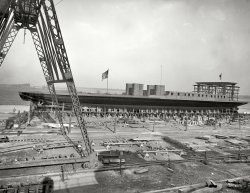
- Merchants & Miners: 1917
- ...
Today's view I think the image was taken from a boat or barge -- love the rail cars on barges. Where the barges are in the ... was either in "P-town" (as it's referred to now) or on a boat in the Elizabeth River, which is the water that you see here. It is less ... Posted by Dave - 11/10/2018 - 11:42am -
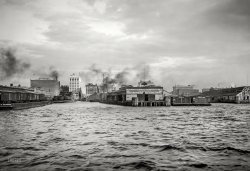
- Jax Landing: 1897
- ... 'shortsighted' of me to overlook the back half of the boat.
Shingles? Are those roofing shingles on the dock?
Lake ... Posted by Dave - 05/11/2015 - 3:36pm -
![Jax Landing: 1897 Florida circa 1897. "Sidewheeler City of Jacksonville at Beresford on the St. Johns." 8x10 inch glass negative by William Henry Jackson. View full size.
Sidewheeler?Looks to me like a sternwheeler.
[Nevertheless, it's a sidewheeler. -tterrace]
Rather 'shortsighted' of me to overlook the back half of the boat.
Shingles?Are those roofing shingles on the dock?
Lake BeresfordIs about 130 miles South of downtown Jacksonville, near Deland. Photo from Lake Beresford Yacht Club dock.
Spanish mossI'm pretty sure what you thought was bundles of roof shingles was actually bales of Spanish moss. Between 1900 and the 30s Spanish moss was produced by southern states like Florida, Lousiana, etc. and shipped north to be used as stuffing and packing material and such.
Spanish moss afireJust such moss was the source of a fire that destroyed much of the city just 4 years after this picture was taken.
(The Gallery, Boats & Bridges, Florida, W.H. Jackson)](https://www.shorpy.com/files/images/SHORPY-4a03600a.thumbnail.jpg)
- Splashdown: 1904
- ...
Defying the cowering hordes of PC drones Big boat faw down and go boom!
There!!! Inspired by the poster commenting on ... Posted by Dave - 08/21/2012 - 1:21pm -

- C&O Canal (Colorized)c: 1925
- ... deck and crew cabin, and the board for passing between the boat and the land, indicate that these boats were in use. So: It is not ... a winter residence and who resided year-around on their boat, Georgetown being one of the places they did so.
(Boats & Bridges, ... Posted by Dennis Klassen - 02/06/2011 - 7:08pm -
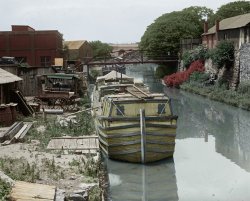
- Chez Philodendron: 1948
- ... All the other waitresses were Irish, recently off the boat and with dazzling brogues. They were whip smart, fast and efficient, older ... Posted by Dave - 03/08/2016 - 10:02pm -
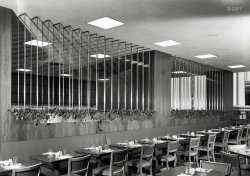
- Union Stockyards: 1941
- ... the late '40s and early '50s, a day at the annual Chicago Boat Show with my parents was always followed up by dinner at the Stockyard ... Posted by Dave - 02/06/2020 - 12:23pm -
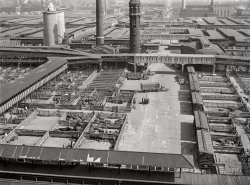
- Lefty for Mayor: 1961
- ... school my dad had a '61 Dodge station wagon. It was a boat but cool in its own way. With a 318 and pushbutton transmission, it was ... Posted by Dave - 07/23/2015 - 10:32am -
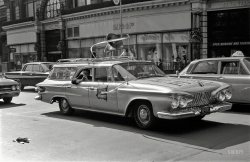
- Growth Spurt: 1912
- ... is a Collier Collier Nr4 probably is a collier, a boat for handling coal, in this particular case, vertically. We've seen on ... Posted by Dave - 08/29/2017 - 7:16am -
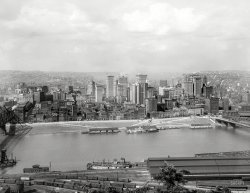
- Flood Relief: 1937
- ... Mack half track crane truck. What a monster. Lifting that boat was probably child's play
Mack truck model AC The rounded cowl ... Posted by Dave - 09/14/2016 - 9:10pm -
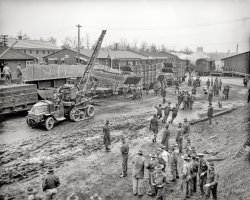
- Peerless Vicksburg: 1909
- ... of the remarkable steel cable rigging holding the whole boat together and the deck flat.
As to the wind-vane, I don't know why it ... Posted by Dave - 02/25/2014 - 11:47am -
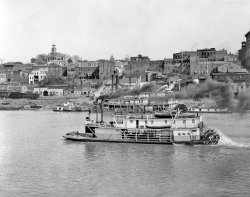
- Gifted Children: 1941
- ... the harbor and catch a cool breeze as we watched a banana boat unloading on Pratt Street. We hoped to see but never did see a boa ... Posted by Dave - 12/22/2015 - 12:28pm -
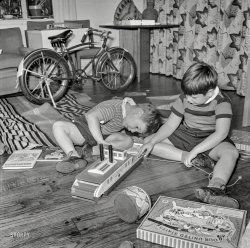
- Cuyahoga Lift Bridge: 1910
- ... throughout its upward swing to provide clearance for boat traffic. It may be single- or double-leafed." At the bottom of the page ... Posted by Dave - 10/13/2018 - 10:36am -

- Naval Gazers: 1943
- ... A few years ago, my son, a Border Patrol agent, took a boat helming course there. Sure brought back some memories for me.
AKA ... Posted by Dave - 06/15/2016 - 1:03am -
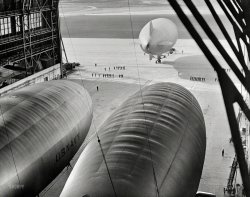
- The Imperial Twins: 1959
- ... giant Imperial much like this one. Washing and waxing that boat was an all-Saturday job; but I still had to find time to mow the grass!
... Posted by tterrace - 06/23/2018 - 6:38pm -
![The Imperial Twins: 1959 My sister-in-law Gimi's maternal grandmother and her identical twin pose with a 1958 Imperial in this Kodacolor print from July 1959. That's all we know for sure, although Gimi believes this is in the Ozarks of Missouri. Other elements give rise to speculation: the right taillight assembly suggests a close encounter with some native plant life, perhaps on a narrow, winding road that brought us hither. The pointing finger I like to think indicates a voice exclaiming "Get those saddle shoes OFF the Imperial!" As for the other orphan footwear, I just want to say I'd rather not look under the Imperial. On a happier note, a 1955 Chevrolet. View full size.
Missouri is a good betThe Chevy in back has a 1959 Missouri license plate.
Imperial DutyWhen I was a kid, I worked summers and weekends at a motel whose owner drove a giant Imperial much like this one. Washing and waxing that boat was an all-Saturday job; but I still had to find time to mow the grass!
Oh those wonderful tallightsChrysler folks nicknamed those taillamps "Sparrow Strainers". These might be referred to as "Shrub Strainers" though.
[It was "Uncle" Tom McCahill, not Chrysler, who coined the term. - Dave]
Uncle Tom McCahill!Thanks, Dave, for reminding us of this fine writer. He was the reason I subscribed to Mechanix Illustrated, and "Mail to McCahill" was the first thing I turned to when a new issue arrived. He could really turn a vivid phrase.
Uncle Tom had a special place in my heart for disputing Ralph Nader's contention that the fun and handsome Corvairs were unsafe. If my 1965 Corvair, "Ol' Paint," was unsafe, it was due to its manic teenaged driver!
Uncle TomThank you for reminding me of my old pal, Tom McCahill. As a young man intent on learning "everything" about automobiles, new and old, I turned to Roger Huntington for deep thinking and theory. But when it came to straight from the hip, no bull reporting, none but Uncle Tom was to be trusted. At least by me. If he said something wallowed in the turns or stopped like a mud flow, it was gospel.
I never learned it all, but those two gave me a decent base for my automobile knowledge.
(ShorpyBlog, Member Gallery, tterrapix)](https://www.shorpy.com/files/images/imperial_twins.thumbnail.jpg)
- Sunrise Service Aboard USS Duane: 1944
- ... you look closely, you will see a cross at the bow of the boat, behind a chaplain reading from a bible. I find this photograph ... Posted by adam-randazzo - 04/27/2011 - 2:17pm -
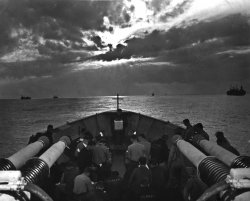
- San Juan Sailboats: 1906
- ... see Spencer Tracy pull up; with a huge Marlin tied to his boat, all chewed up by sharks.
[One of these? Or did you mean "marlin"? ... Posted by Dave - 03/06/2019 - 11:32am -
![San Juan Sailboats: 1906 Puerto Rico circa 1906. "Native sailboats -- San Juan." 8x10 inch dry plate glass negative, Detroit Publishing Company. View full size.
At first "impression"This interesting photo brings fanciful thoughts of Claude Monet painting Ernest Hemingway's story of an old man.
Theft preventionIt seems that you take your tiller bar with you like an ignition key. Rather a lot for the pocket!
Looks Like A Still Out Of A Classic Bogey FilmIs it 'To Have And Have Not' or 'Key Largo'?
The Old Man and the SeaI keep expecting to see Spencer Tracy pull up; with a huge Marlin tied to his boat, all chewed up by sharks.
[One of these? Or did you mean "marlin"? -tterrace]
Source MaterialThis photo could have been inspiration for a Winslow Homer watercolor.
(The Gallery, Boats & Bridges, DPC, Puerto Rico)](https://www.shorpy.com/files/images/SHORPY_4a11146a.thumbnail.jpg)
- Truck Stop Cafe: 1940
- ... good!
Not that different than today except for the boat captain hats, they just wear ball caps now.
I drove truck OTR for about ... Posted by Dave - 08/24/2012 - 2:10pm -
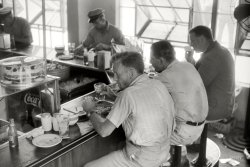
- Hoboken Public Bath: 1905
- ... She served as General Grant's personal dispatch boat on the Chesapeake Bay, and carried messages and troops across the bay and ... Posted by Dave - 02/13/2017 - 10:44am -
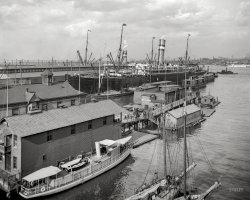
- Chicks Ahoy: 1927
- ... I would rather walk the plank than join those ladies in a boat ride. Their eyes look like they've been smokin' left-handed cigarettes. ... Posted by Dave - 09/11/2011 - 1:27pm -
